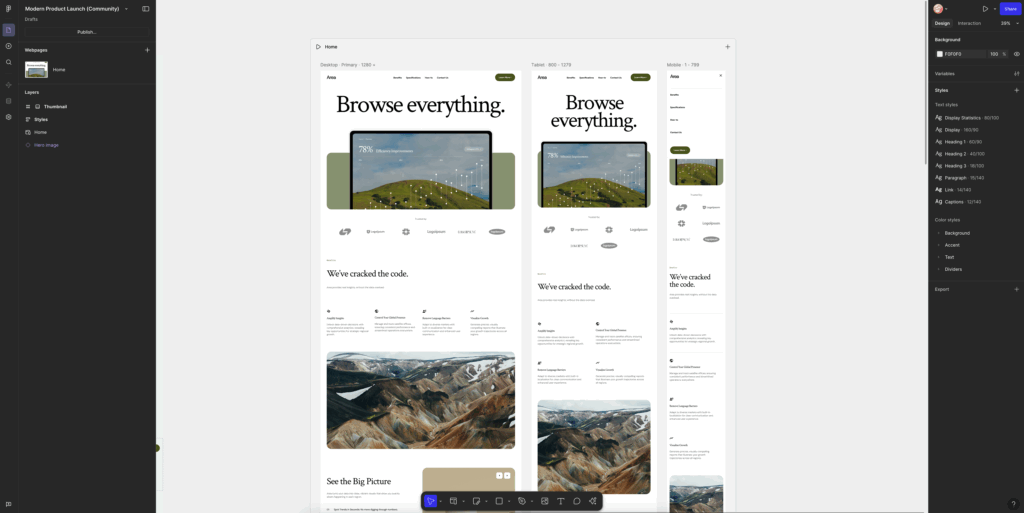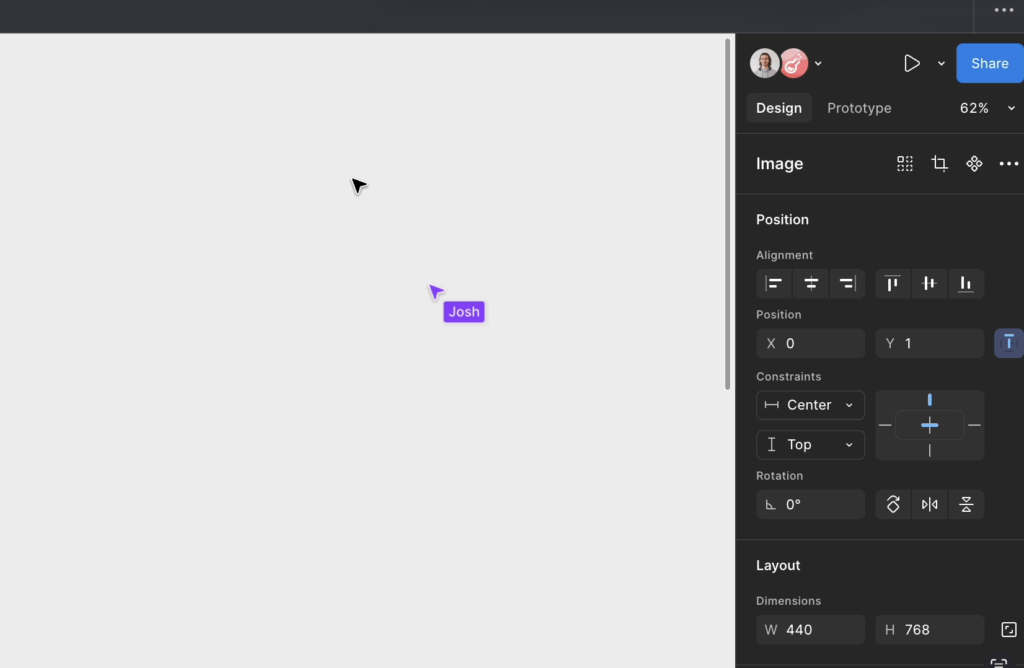Today, I’m going to compare Figma and InDesign, two tools I’ve been using for a while now (it’s important to acknowledge that I have used InDesign much longer than Figma). For me, it’s not just about picking favourites here; it’s about helping you find the right tool for your creative needs, whether you’re a graphic design, UX designer or just starting out in design.
By the end of this blog, you should better understand which platform aligns with your workflow and goals.
Let’s dive in and explore them together.
What is Figma?
Figma is an innovative, fully cloud-based design software perfect for creating interactive web design layouts and delivering UI/UX projects. It’s also a place to sketch ideas and even create wireframes without downloading or installing anything. This is probably one of the reasons why Figma’s user base grew by 30% in the past year.
Oh, and let’s not forget, it’s accessible from any device (as long as you have WiFi!). Its interface is extremely intuitive, making it a favourite among beginner and expert designers. Figma has you covered whether you’re on a Mac or PC.
It’s like a Swiss Army knife for designers, all in a tidy, browser-based package.

What are the main benefits and key features of Figma?
The perfect collaboration tool
Figma’s collaborative features are used by 80% of its user base. These features allow multiple people to work on a project simultaneously. It’s like an online party where everyone can join from anywhere, and no one needs to wait for their turn.
Instant feedback from clients
Remember waiting forever for clients to respond? Those days are over. Figma supports real-time collaboration, reducing project time by 30%. Clients can drop comments directly on the design, and it’s like they’re right there with you. It’s fantastic! Faster feedback means you can finish projects quicker and look like a pro.
Massive component library
If you’re like me and love being organised, you’ll appreciate Figma’s component libraries for keeping things consistent.
Seamless handover to devs
For designer-developer teams, Figma makes handing projects over to developers super smooth. You can mix, match, check, and export without losing files or messing up layers.
No need for version control chaos
The best part? There’s no more version control mess. Forget about those confusing file names like file_v23_FINAL_FINAL(1) .psd. With Figma, you’ve always got the most up-to-date version ready.
What are the main differences between Figma and InDesign?
Firstly, Figma: It truly excels as a collaborative design tool. Its cloud-based nature addresses the perpetual problem of “version control issues.” With real-time collaboration capabilities, it’s well-suited for teams working together on projects. It’s also cost-effective, making it an ideal option for budget-conscious designers.

Then we have InDesign: It’s a reliable tool with a strong reputation in the industry. InDesign is highly regarded for its complex page layout capabilities, making it an excellent choice for those working with brochures, books, or larger print projects. However, it’s less geared towards collaboration, often favouring solo projects and individual effort.
Ultimately, if you’re seeking a collaborative, web-based tool that’s budget-friendly, Figma could be the right fit. In my opinion, InDesign is more suitable for those who focus on print design and work independently.
A comparison in table format
| Feature | Figma | InDesign |
| Primary use | UI/UX design and web design | Print & digital publishing |
| Collaboration | Real-time with multiple users | Limited, mainly file sharing |
| Learning curve | Moderate for designers | Steeper, more traditional features and training required |
| Data visualisation | Basic, with plugins | Extensive, with a graphic design focus |
| Platform | Web-based with cross-platform support | Desktop application, Windows and macOS |
| Pricing | Free to use with premium plans | Subscription-based |
How do Figma’s prototyping features compare to InDesign’s?
While Figma shines with its intuitive prototyping tools, offering real-time collaboration, effortless interactions, and seamless animations, InDesign is more geared towards static, print-focused designs, lacking the interactive functionality that Figma users enjoy.
If you’re looking for a dynamic and collaborative design experience with robust prototyping capabilities, Figma takes the crown. InDesign, on the other hand, remains an excellent choice for traditional print projects, but it falls short in modern digital interactivity.
Final thoughts
So, we’ve checked out the ups and downs of Figma and InDesign.
Who knew looking at design tools could be this fun? But seriously, here’s the thing: Figma’s your pick if you’re after something slick and perfect for online teamwork.
On the flip side, if you love solid, reliable work for print and top-notch typography (because, who doesn’t?), InDesign is your choice. It might take some time to master, but you’ll end up with something truly professional.
In the end, what’s best depends on what you need. Are you designing sleek web interfaces with your team or crafting a stunning magazine layout independently? Whatever you choose, remember to have fun because design isn’t just about the final product. It’s also about enjoying the creative process!
Cheers to creating awesome stuff, whichever tool you pick!





